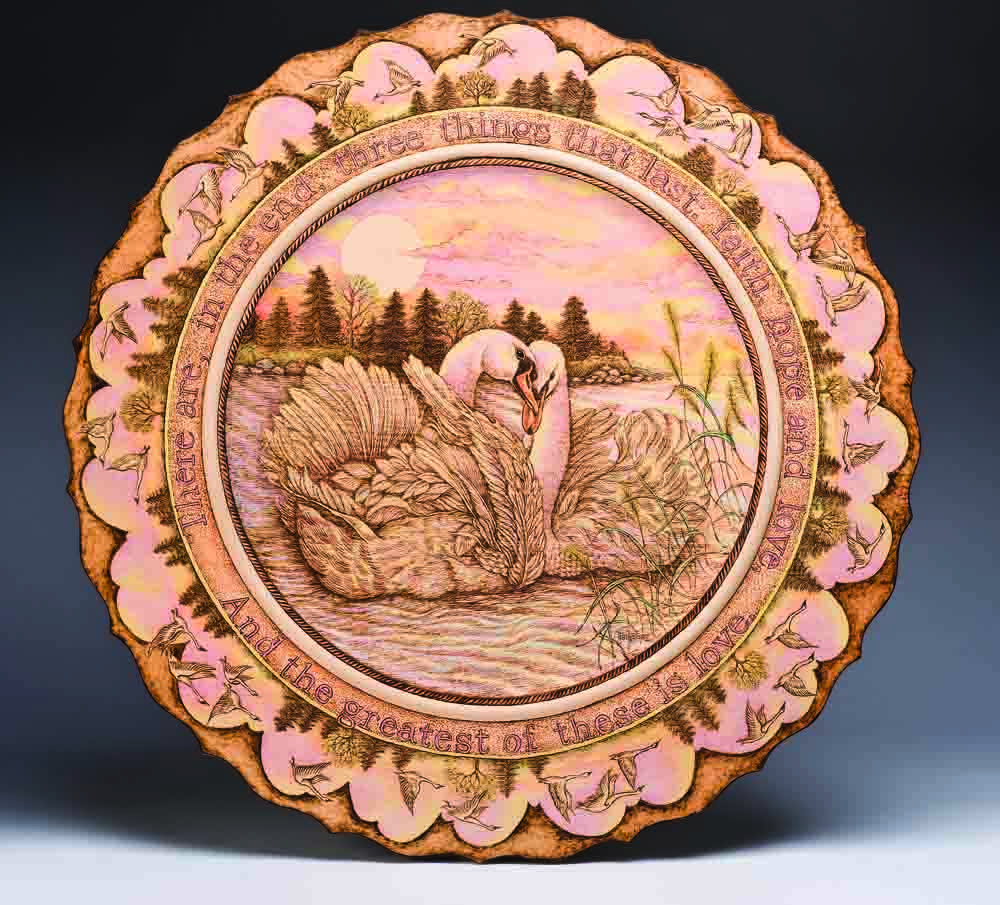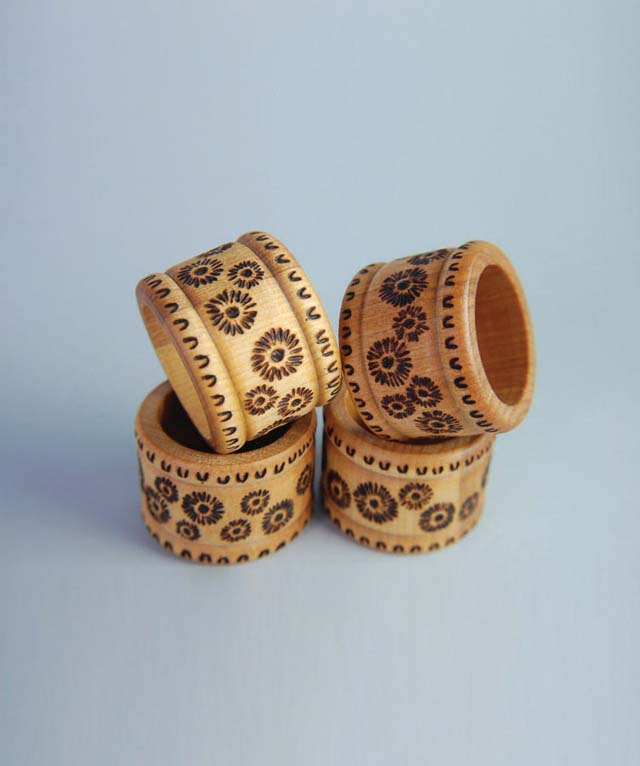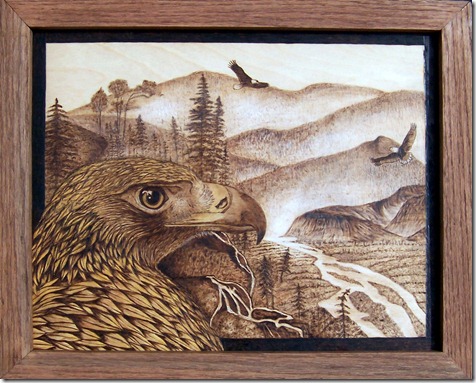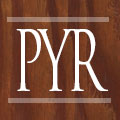Deborah Pompano brings a lifetime of experience to her pyrographic projects.
Every so often an artist has so much to say and says it so well that, rather than try to write an article about her, I simply hand her the metaphorical microphone. I hope you enjoy this visit with the multi-talented artist Deborah Pompano as much as I did. ~Mindy Kinsey, assoc. managing editor
I was very lucky to grow up in a large family with four sisters, in Norwich, Conn. My parents, Dorothy and Sidney Beller, were both very creative people. Dad was a certified public accountant but his real love was woodworking, and our entire basement was filled with saws and tools. He always had a project going and built everything from a cedar closet for our clothes, to bookcases, to a handsome inlaid map of the United States, made from 50 different types of wood veneers! Dad’s other loves were playing the piano and gardening. I am grateful to have inherited Dad’s love of wood, nature, and music.
My mother was also very creative, loved to sew, and taught all five of us girls to make our own clothes. She knitted, crocheted, did beautiful crewel embroidery, and cooked incredible meals. She collected and often read to us the great books of art, music, and literature, which she bought on the installment plan at the local grocery store or through the mail. She would never allow us to complain that we were “bored” but insisted that we find creative things to do–and we did! Mom also fostered a great love of wildlife in me with frequent trips to the Mohegan Park Zoo in Norwich, which was filled with deer, owls, hawks, and even a monkey house.
Our local public high school, which was a very large regional school called the Norwich Free Academy, housed the fabulous Slater Museum and Art School, and I am so thankful to Mom for driving me there every Saturday morning throughout my elementary school years for drawing, painting, and pottery classes. We didn’t have computers or video games, of course, just an old black and white TV, so I had plenty of time to climb the big pine trees in our yard, sew, explore nature, read, play the piano, ride my bike, roller skate, paint and draw, and dream. I am so grateful for the wonderful childhood that I had. I know I would not be an artist today if it were not for those cherished years, which I shared with my four sisters, Margie, Wendy, Laurie, and Sandy.
I attended the University of Connecticut as an art major and met my husband Joe there in 1971. We lived in western Massachusetts for many years, and I received my B.A. degree and teaching certification in elementary education and art education from the University of Massachusetts, Amherst, in 1978. In 1981, we moved to Virginia. Joe and I live in a cozy old house in Hanover. We have raised three wonderful daughters, Rachel, Rebecca, and Laura, and now share our home with our two dogs, Corky (a Corgi/Border collie mix) and SnowBear (a Maltese).
I am inspired by books, nature, poetry, gardens, museums, and music. I like to take classes and participate in workshops and outings with friends, and I enjoy being a part of the artistic community in our area–I am a member of the Metropolitan Richmond Artists Association and have recently become a member of the Virginia Watercolor Society. Since 2002, the daily practice of centering prayer has been a big influence on me spiritually. I also enjoy and am inspired by taking long walks with my dog and doing yoga.
Many Hats
I have worn many artistic hats over the years. I’ve had jobs as diverse as public school elementary school teacher, freelance portrait artist at shopping malls and art shows, and teaching in my own art school. I have worked as a landscape artist, and for three years, I rented a studio and ran an art school, where I taught classes for children and adults in drawing and painting. I created 22 full-color book cover illustrations for Thorndike Press in Portland, Maine, and created two Christmas greeting card designs for Sunrise Publications, in Indiana. In addition, for the past 22 years I have taught piano lessons in my home studio, the Harvest Moon Studio. I am a “hobbyist music teacher,” which means I teach all styles of music in addition to classical–Broadway, Disney, jazz, blues, sacred, or pop. I love music and enjoy the interaction of teaching, and by earning my living with music, I have been free to explore new directions with art.
I started out doing black and white drawing with graphite, charcoal, and pen and ink in my twenties, mostly of wildlife, landscape scenes, and portraits. For many years after that I explored scrimshaw, carving intricate designs into whalebone and elephant ivory to create jewelry, when it was still legal to use these materials.
As I got older, I wanted to try using color more, so I explored pastels for about 15 years. Using pastels was a lot like simply drawing and felt very comfortable to me. I studied the work of a lot of artists, in books and at workshops, worked on Wallis sanded pastel paper, and did a lot of landscapes in an Impressionistic or realistic style, as well as portraits. On the down side, it was expensive to frame these pieces because they needed to be double-matted with a space between the glass and the art. Pus, they were fragile to store or transport to art shows, since the pastel dust would drift down on the mats, and they would have to be re-matted and framed frequently. The pastels were not very portable for outdoor work, and although other artists are able to achieve incredible detail with pastels, I was not satisfied with my pictures,.
I then branched out for 10 years into water-based oils on canvas, which were easier to frame. I was again doing landscapes and portraits, often based on my pastel studies. I had some success with oils, but I became frustrated with my oil painting work because I wanted to achieve a more delicate, finely detailed touch and was unable to accomplish this with the oils. I thought my oil portraits looked cartoony and unrealistic, and I felt like I was pushing goopy, thick paint around. Oils were the wrong medium for me.
I saw a museum exhibit by the illustrator Jerry Pinckney and was bowled over by the beauty and originality of his work. I also began to study the illustrations of Beatrix Potter and many other artists who work in pen and ink and watercolor, such as Marjolein Bastin. I just loved the delicacy and subtle nuances they achieved. I missed drawing, too, so I began searching for a new medium that could better express my desire for more detail and that would feel more in alignment with my own natural abilities and comfort zone.
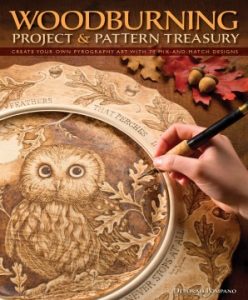
Discovering Pyrography
Discovering woodburning in 2003 was a major breakthrough for me because it brought me back to drawing and shading, which I love. I was at a local craft show and saw a small woodburned portrait of a craggy Indian face on a basswood plaque. I had never seen woodburning before, and I just fell in love with the unique medium of drawing on wood. It provides such a warm, natural, and interesting background to the sepia-toned, engraved-looking burned lines. The beauty of the wood itself makes each piece totally unique. I had never seen anything quite as unique and beautiful as this. It looked very rustic and old-fashioned, which also greatly appealed to me.
I had been searching for a new medium to work in, one where I could combine images with poetry, inspirational verse, or scripture passages and create borders that would express in a very personal way the spiritual realities and love of nature that I hold most dear. I kept this work to myself for four years–it was solely for my own personal growth and expression. I didn’t try to sell it or put it out in public at shows. By allowing myself this privacy, I didn’t worry about what other people would think and was completely free of the paralyzing tyranny that artists experience at art shows–worrying about whether or not the artwork would sell. I loved playing with the poems, words, and images and creating compositions that made me happy.
I was greatly challenged by how much I needed to learn about woodburning, since I started out knowing absolutely nothing! In terms of choosing a woodburner and learning wood types and shading and coloring techniques, it took a great deal of experimentation. Many projects didn’t come out as well as I would have liked before I was able to achieve consistently gratifying results.
I worked for a year with a Walnut Hollow one-temperature woodburner. I had a lot of trouble with burning “blobs” and holes in the wood and was unable to control my lines as well as I wanted. When a friend told me about the Woodcraft store, I discovered variable-temperature woodburning machines and books on woodburning by Stephen Poole and Sue Walters. I worked with the Janik woodburner that Stephen Poole recommended for three years, which necessitated creating my own tips out of nichrome wire.
One of the most important things I learned was to plan my compositions and designs on tracing paper patterns first, rather than trying to draw and design freehand on the wood. The hours I put into designing the patterns and then transferring them to the wood were well worth the time invested. It’s hard to erase a woodburned line!
I also experimented with wood. My favorite woodburning surface is basswood–either hand-turned platters or plaques with bark around the edges. I also like to work on birch plywood, being careful to select pieces of wood with the least amount of wood grain.
Then, after almost four years of studying and experimenting on my own, I saw in the travel section of our local newspaper an article about the John C. Campbell Folk School in Brasstown, N.C. I noticed that they offered woodburning classes there, so I signed up for a class with Orchid Davis. That class changed my life in very big ways!
Orchid taught me how to use the Colwood Detailer woodburner and tips, which I still use. It was so wonderful not to have to make my own tips, since I am not very mechanically gifted. I really appreciate the great variety of tips Colwood has to offer. Orchid’s excellent instruction and kind, caring encouragement were invaluable to me, and I was very honored to be asked by her to teach woodburning classes at the Folk School, which I began in August 2009. I have been teaching at the Folk School every summer since then. It is a unique environment, situated on a beautiful, historic property in the mountains of southwestern North Carolina, where students can learn new skills in a fun and noncompetitive setting. I highly recommend the Folk School to all who love arts and crafts of all kinds.

Adding Color
I am experimenting and learning the best ways to apply color to woodburnings. This is something I want to continue exploring, since I am not entirely satisfied with the methods I have used so far.
I have had unsatisfactory results using oil paints thinned with linseed oil medium, because the linseed oil seems to pull the dark, burned matter out of the woodburned lines. I have had to burn most of the lines again after coloring, which was quite frustrating and time-consuming. I have also had this problem with rub-on wood finishes unless I use them very lightly–only one coat. I have had more success using oil paints thinned with mineral spirits or watercolor washes. However, with both of these techniques, I have still had to burn some of the woodburned lines again to re-emphasize them in the colored areas.
And, I have sometimes found it difficult to re-burn lines after using watercolor or oil paint. The wood seems to resist being re-burned after being painted, and I have been disappointed at losing the finest lines and the crispness of my lines in the colored areas. This is something I plan to study and work on intensively in the future, because I love color and don’t want my woodburned lines to be compromised after all that work!
Recently I have been successfully coloring my woodburnings with Faber-Castell Polychromos colored pencils. These pencils have a much lower wax content than other brands. (Wax build-up can cause bloom, which is a cloudy or milky-looking glaze over the woodburned lines.) I like the subtle, soft look of these pencils, and they are easy to control.
Nothing Is Ever Lost
I like to learn new things and to take classes. It’s fun and exciting to study with new teachers and to meet other artists and work quietly together, sharing our favorite books and art materials and learning from each other’s frustrations and successes. I have enjoyed taking classes at the Lewis Ginter Botanical Garden and the Virginia Museum of Fine Arts, both in Richmond, Va., as well as at the John C. Campbell Folk School in Brasstown, N.C., where I’ve studied woodburning, painting, photography, and gardening. It’s also fun to go on week-long workshops to study art–and a good excuse to have a travel adventure! I enjoy switching off between woodburning projects and watercolor painting–it keeps me from becoming burned out in either medium and keeps me feeling fresh and excited about making art.
I really believe that nothing is ever lost and that the experimentation I’ve done with many mediums, and my failures and successes with each, has taught me so much. Mistakes can sometimes teach you much more than successes, and the knowledge you gain will be taken to the next piece you work on. I think the most important things are to enjoy what you are working on, to experiment and be free, and to do work that has meaning for you.
I’ve learned that it’s all about the love of making art with feeling and passion–it’s not satisfying to me simply to be a good technician. I think it is important to woodburn and paint the things that move and excite me so I can’t wait to get into the magic of it. I want to feel that my heart and emotions are in the work and that it has personal meaning.
And In The End…
I have met so many interesting, creative, and talented people as I have explored this fascinating craft of woodburning, and I have had experiences and adventures that I never would have had, otherwise. In 2006, I submitted photographs of my woodburning work to the readers’ gallery of Creative Woodworks and Crafts magazine and was incredibly excited to have these photographs of my work included in the magazine. Then, the editor sent a writer and photographer to do an article about my work, “Woodburning Artist – Deborah Pompano,” which was published in the August 2006 issue. This was an amazing experience for me and was a real affirmation that I was on a good path. The same editor began a new magazine called Pure Inspiration and featured me in an article called “Deborah Pompano, a Personal Search for Meaning, Truth and Beauty” in Fall 2006.
However, by far the most exciting event and honor in my artistic life has been the opportunity to write a woodburning book for Fox Chapel Publishing, Woodburning Project & Pattern Treasury. It means so much to have an opportunity to share my love of nature, wildlife, and art with others through creating patterns and projects. It is truly a dream come true, which began back in 2003 with a chance encounter with that small woodburned portrait of a wise Indian face. I am so thankful that the Creator has led me along this journey of artistic discovery and has blessed me with these incredible opportunities and the chance to meet and work with such talented and creative people.

See more of Deborah Pompano’s work at her website, www.harvestmoonstudio.net. Check out her book, Woodburning Project & Pattern Treasury, at www.foxchapelpublishing.com.
- Of Such Frail Things A Tree Is Made
- Ode to Joy
- I’ll Put A Trinket On
- Hope Is The Thing With Feathers
- Squirrel Nutkin
- Snow Bear

